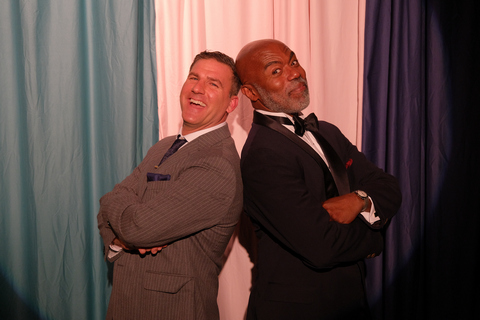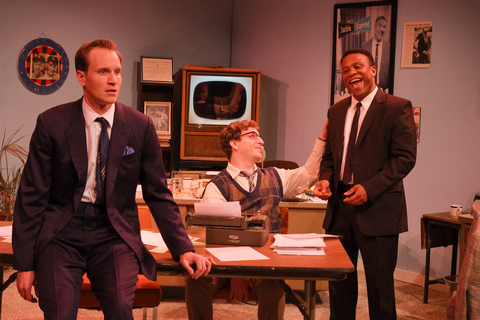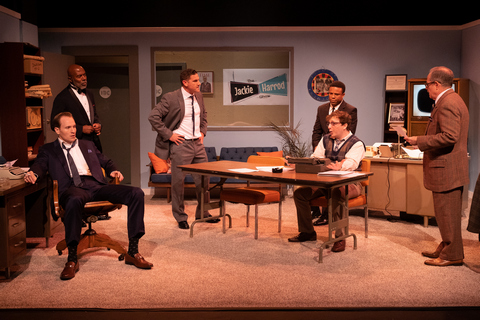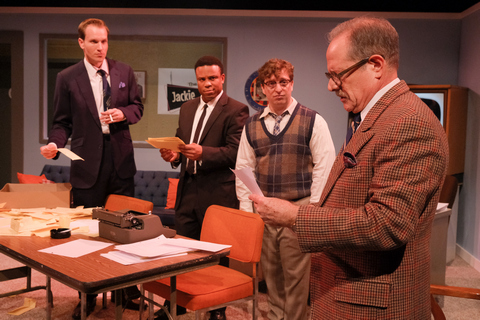What Passes for Comedy
A serious look at racism and anti-Semitism in the golden age of live television when one mistake sent out on the airwaves could wreck multiple careers.

Michael Filisky and Ryan Brooke Taylor in a scene from G.D. Kimble’s “What Passes for Comedy” at The Chain Theatre (Photo credit: Reiko Yoo)
[avatar user=”Victor Gluck” size=”96″ align=”left”] Victor Gluck, Editor-in-Chief[/avatar]
While G.D. Kimble’s What Passes for Comedy hints that it might be funny, in fact it is a serious look at racism and anti-Semitism in the golden age of live television. Unlike Neil Simon’s Laughter on the 23rd Floor which deals with the economics of early television and the compromises necessary, What Passes for Comedy set in 1963 sometime after the March on Washington concerns the fallout after a late night talk show host reads the wrong cue card on air landing a punchline that is politically and socially unacceptable. As described succinctly in the press materials, “the three young writers behind the prank find themselves in the fight for their professional lives as celebrity guests drop out, the head of the network is out for blood and an all-night work session reveals hard truths.” The premise is fascinating; the execution by the playwright uneven.
The three writers are the de facto head of the group, Will Holly, an untalented WASP whose father is a big tycoon in another field; Adam “Zep” Beber, a Jewish comic with a penchant for knock knock jokes, and Tory Browne, a Black whiz kid with a Harvard degree and the editorship of the Harvard Lampoon on his resumé. While they have been working together for a year and a half, the clueless Will has no idea what life has been like for his Jewish and African American colleagues. Although they are writing for the number one rated television show in America, their host Jack Harrod has limited abilities and his side kick, the African American Bunny Brown, plays an Uncle Tom character for which Tory has been hired to create the jive to his everlasting regret.

Andrew O’Shanick, Jordan Elman and Alain Pierre in a scene from G.D. Kimble’s “What Passes for Comedy” at The Chain Theatre (Photo credit: Reiko Yoo)
The play’s real theme of racism in television is only depicted part of the time. The play meanders around several different topics from bad television to corporate politics to writers block to colleague dynamics to work created by committee. There are terrific scenes all of which go on a bit too long and others that seem to be only fillers. At two and a quarter hours, the play can’t sustain itself as so little happens. There is little evidence of real humor though the point may be that mediocre is the rule in television. Set 60 years ago, the play ignores the question of how much of this still goes on in 2022 which will be on audiences’ minds as they watch this play.
While director Rick Hamilton keeps the events bubbling along, some of the acting is one-dimensional though other actors seem to the manner born. Best is Stan Buturla as network CEO Bob Borden, suave and elegant, putting us in mind of early television mogul William S. Paley and David Susskind. Weakest is Andrew O’Shanick as WASP head writer Will Holly who is the same throughout even when he supposedly learns from his mistakes. Alain Pierre as the sole Black writer is crisp and clear in his delivery but lacks nuance in his anger, resentment and exasperation. Jordan Elman as the Jewish writer is amusing but not as humorous as his role should be due to his unfunny material.

Andrew O’Shanick, Ryan Brooke Taylor, Michael Filisky, Alain Pierre, Jordan Elman and Rory Lance in a scene from G.D. Kimble’s “What Passes for Comedy” at The Chain Theatre (Photo credit: Reiko Yoo)
If the play is meant as satire with its depiction of long-known clichés, it is not entirely successful, the groans missing from the flat humor. As the famed talk show host Jack Harrod, Michael Filisky lacks the charisma which would explain his rise to fame on the lines of Steve Allen, Jack Paar or Johnny Carson. Ryan Brooke Taylor’s Bunny Brown is a band leader and side kick reminiscent of straight man Doc Severinsen, Johnny Carson’s famed cohort, except here he is an African American like Jack Benny’s Eddie Anderson. Taylor is unusually angry throughout without explanation although he claims to be proud of how far he has climbed in American culture. As the show’s producer Jerry Schaal, Rory Lance recycles most of the stereotypes of the harried boss with the problems of the show on his shoulders. The fact that there are no women characters is typical of television writers’ rooms in the 1950’s and 60’s.
The physical production is quite realistic and convincing. The detailed set by E.A. Frank leaves nothing to the imagination, while Debbi Hobson’s costumes remind us of the days when all office workers wore sober suits and ties to their jobs. Michael Abrams’ suitable lighting remains brightly lit except for a few transition scenes to show the passing of time. David Rey’s authentic production video does appropriate job suggesting The Tonight Show in its clips from fictitious The Jack Harrod Show. The excellent sound design is the work of Greg Russ. Robert Pound is responsible for the standard original music.

Andrew O’Shanick, Alain Pierre, Jordan Elman and Rory Lance in a scene from G.D. Kimble’s “What Passes for Comedy” at The Chain Theatre (Photo credit: Reiko Yoo)
G.D. Kimble’s What Passes for Comedy depicts the fascinating era of early live television talk shows and the racism and anti-Semitism which was acceptable in those days. However, it also hints at hilarious comic interludes which it does not deliver. A much better play is hiding in this material and a rewrite could make it a much more successful evening. Its lack of focus camouflages its real intentions which are quite admirable. The play is also hampered by its conventional structure which requires a good many unnecessary exchanges. Nevertheless, this is an admirable attempt at something a little different from the usual run of historical plays on the stage, an absorbing evening even when it is not clear exactly where it is going.
What Passes for Comedy (through November 19, 2022)
The Chain Theatre, 312 W. 36th Street, Third Floor, in Manhattan
For tickets, visit http://www.chaintheatre.org
Running time: two hours and 30 minutes with one intermission






Leave a comment